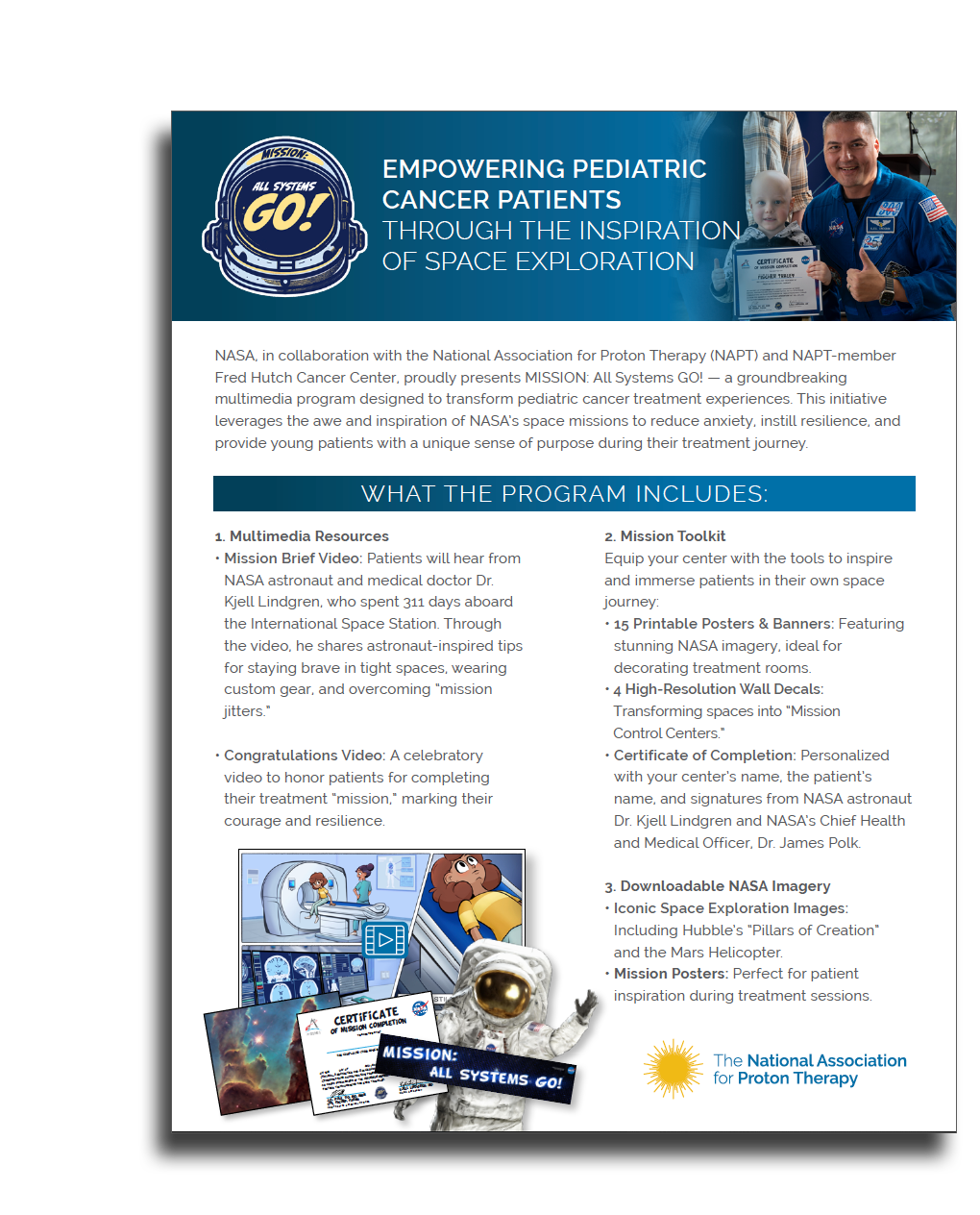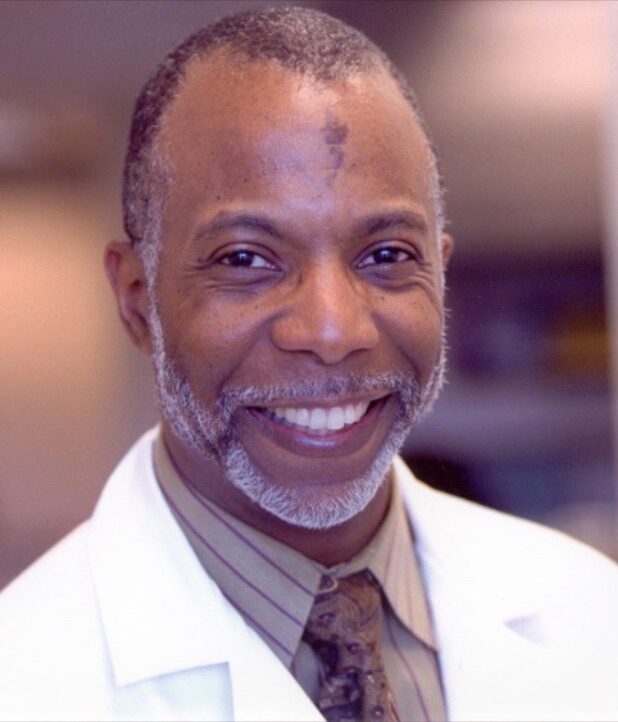GUEST CONTRIBUTOR:
Corrie T. M. Anderson, M.D., FAAP
Professor, Anesthesiology and Pain Medicine
Professor of Pediatrics (adj)
University of Washington | Seattle Children’s
At the intersection of pediatric cancer treatment and space exploration, an innovative program is helping young patients navigate their proton therapy journey with greater confidence and reduced anxiety. We spoke with Dr. Corrie Anderson, a pediatric anesthesiologist at Seattle Children’s Hospital, to learn more about his work in pediatric proton therapy—and how his lifelong passion for NASA inspired a unique initiative that is transforming patient experiences.
A Passion for Pediatrics and a Connection to Space
Dr. Anderson has dedicated his career to caring for children, emphasizing the privilege and responsibility of making a positive impact at such a formative stage in life.
“Working with kids is a blessing,” he shares. “They don’t judge you; they just want to know if you’re fun and cool. It’s an incredible opportunity to be a role model.” His interest in space began in childhood, inspired by witnessing the moon landing.
“I always dreamed of being an astronaut,”
he recalls. “There are so many parallels between what we do in proton therapy and space missions—from the technology to the precision involved in each step. When I met someone from NASA, I was excited to share ideas, and it happened to align with a young patient’s dream of becoming an astronaut. That moment sparked something bigger.”
The Birth of an Idea: Connecting NASA and Pediatric Proton Therapy

Through a connection with NASA’s outreach program, Dr. Anderson saw an opportunity to bring a sense of wonder and adventure to pediatric proton therapy.
“NASA’s mission and the Cancer Moonshot initiatie both strive for groundbreaking progress,” he explains. “We wanted to create something meaningful and engaging for children undergoing treatment.”
Bringing this vision to life took two years of planning and collaboration. Al Feinberg from NASA and April Clements from Fred Hutch Cancer Center played a significant role in transforming Dr. Anderson’s idea into reality, ensuring the program successfully engaged and inspired young patients. With support from the National Association of Proton Therapy, the program is now sustainable and scalable to all radiation oncology departments.
The result was NASA MISSION: All Systems GO!—a groundbreaking multimedia program designed to transform pediatric cancer treatment experiences. This initiative leverages the awe and inspiration of NASA’s space missions to reduce anxiety, instill resilience, and provide young patients with a unique sense of purpose during their treatment journey.
The program immerses children in a space-themed experience, featuring a video with engaging animations featuring NASA Astronaut, Kjell Lindgren. “Watching children see themselves in the program is mesmerizing,” Dr. Anderson says. “It makes treatment feel like a mission rather than something scary.”
Reducing Anxiety and Improving Outcomes
Pediatric patients often experience significant anxiety before treatment, which can impact their physiological and psychological well-being. “The unknown is what makes them most nervous,” Dr. Anderson notes. “By providing a relatable and exciting framework—like a NASA mission—we help reduce that fear.” Lowering anxiety has tangible benefits.
“When children are less anxious, they often require less anesthesia,”
he explains. “This means shorter recovery times, fewer dietary restrictions, reduced weight loss, and more efficient treatment sessions. It also supports families—when parents are calmer, children tend to be less anxious too.”
Bringing NASA MISSION: All Systems GO! to Your Treatment Center

Click above to download the NAPT Overview on this invaluable NASA program for more on how to implement it in your proton therapy center!
A key goal of NASA MISSION: All Systems GO! is making it accessible to as many young patients as possible. The program is available to all radiation therapy centers in the U.S., with NAPT member centers able to download the full set of assets from NASA for free.
“We wanted to create something that any treatment center could implement without barriers,” Dr. Anderson explains. “When children see themselves as astronauts on a mission, it completely reframes their experience. It reduces fear, builds confidence, and makes treatment something they can take pride in.”
By integrating this space-themed program, treatment centers can provide young patients with an engaging, mission-driven framework that reduces anxiety and enhances the overall treatment experience.
“Having champions on staff who are open to new ideas makes all the difference,” Dr. Anderson adds. “The more we tap into what excites and inspires kids, the more we can transform the way they experience care.”
To learn more about how to implement NASA MISSION: All Systems GO! at your center, visit the NASA website and download the free program assets today.
Looking Ahead: The Future of Pediatric Care
Dr. Anderson believes the lessons learned from this initiative can be applied across pediatric medicine.
“We need to think beyond traditional approaches and find creative ways to ease the patient experience,” he says. “Healthcare providers should consistently look for ways to innovate. If we can tap into what excites and inspires children, we can transform how they experience care.”
A Message for Young Patients
Reflecting on the program’s impact, Dr. Anderson feels immense gratitude.
“Knowing that this idea is helping children face treatment with confidence is incredibly rewarding,” he shares.
When asked what message he would share with young patients embarking on their own ‘missions,’ he offers this encouragement:
“You are braver and stronger than you know. Like every astronaut, you have a team supporting you. Believe in yourself—you’ve got this!”
EXPERTISE UNVEILED: A GUEST CONTRIBUTOR SERIES
We bring together the brightest minds and most experienced professionals in the field of proton therapy. In this distinguished guest contributor series, experts share invaluable insights, breakthrough research, and real-world experiences in advancing proton therapy. Join us as we delve into the world of proton therapy, exploring its intricacies and potential through the eyes of those who know it best. Interested in becoming a contributor? Email info@proton-therapy.org for more information.





